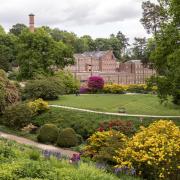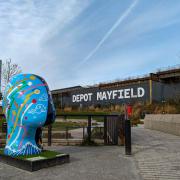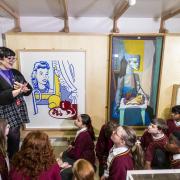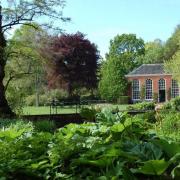We select some of the best things to see and do in Llangollen
Whether you want a day out, a weekend away or a longer break there is always something to do in the vibrant town of Llangollen, which has many natural wonders. As well as mountains, white water rivers and the canals, where you can take more leisurely watery trips on horse drawn canal boats there’s a whole host of castles and forts, gardens and historic buildings to visit. You won’t want to miss out on a trip on the Llangollen Steam Railway either which takes you through some of the most beautiful scenery in the country. Here we reveal the top ten wonders of Llangollen to help you plan your visit.
LLANGOLLEN BRIDGE As well as providing a superb viewing platform for canoeing events held on the river, Llangollen Bridge is one of the town’s true icons with great historical importance. The first stone bridge is believed to have been constructed by John Trevor I, Bishop of St Asaph in 1345. Over the years the bridge has been rebuilt and been widened twice as well as having an extra arch added to allow the railway into the town.
LLANGOLLEN STEAM RAILWAY The last steam train to puff into Llangollen station was in 1968. The buildings and track were left to the mercy of mother nature for seven years before a group of local enthusiasts began to preserve the station, 60 feet of track was laid and the Llangollen Heritage Steam Railway was born. As volunteer numbers grew so did the track and today it provides seven and a half miles of the most beautiful scenery from Llangollen over the Berwyn Viaduct, through the Dee Valley with the river on one side and the Berwyn mountains on the other before reaching the charming station at Carrog.
THE HORSESHOE PASS Climbing from Llangollen around the valley to form the shape of a horseshoe (hence the name), the A542 to the Horseshoe Pass has some of the most spectacular views in Wales. Once a stage in the annual Tour of Britain cycle race, the road dates from 1811 as part of a major turnpike road. A caf� near the summit is popular with tourists, motorcyclists and even helicopters which can land there. It’s also popular with walkers as the pass is a great starting point for moorland walks and trails to the summit of Llantysilo Mountain.
THE BERWYN MOUNTAINS Everyone has heard of Snowdonia, but the Berwyn Mountains remain relatively unknown and are one of North Wales’s greatest natural secrets. Stretching all the way from Llangollen along the Dee Valley to Bala, the highest peak is Cadair Berwyn, which stands at 830 metres, but there are 24 peaks above 600 metres high. A haven for wildlife, the mountain tops are home to birds like merlins and red kites, as well as rare plants.
DINAS BRAN CASTLE After completion Dinas Bran Castle was held by the Prince of Powys for just 20 years before it was surrendered to Henry de Lacy, who burned the castle down. Never rebuilt, the fact that there are still ruins there is testament to the strength of the original structure and an air of mystery still surrounds the place. Bran is reportedly the builder of the first castle structure in the old Iron Age fort as well as being a protector of the Holy Grail.
The name Bran means cow or raven in Welsh and another story of Bran has him being beheaded and his head buried beneath Tower Hill in London, which is why the raven is such an important bird to the Tower today.
THE CHAIN BRIDGE The first Llangollen Chain Bridge was completed in 1814, but there has been a crossing point over the River Dee at Berwyn as far back as Roman times. Made of wood, with chains slung underneath, it survived until 1870, when it had a complete refurbishment by famous engineer Sir Henry Robinson, owner of the Brymbo Iron Works.
LLANGOLLEN CANAL AND AQUEDUCT The Pontcysyllte Aqueduct and Llangollen Canal is a World Heritage site. Today the canal, which twists through the beautiful Welsh hills and across the Dee Valley on the famous aqueduct, is one of the busiest in Britain and is an important part of the town’s attraction as a holiday destination, with many colourful narrowboats to be seen. You can also take horse drawn or motorised boat trips along the canal and across the aqueduct which was officially opened in 1805 and cost the then considerable sum of �47,000. It features 19 supporting pillars, some up to 116 feet high, connected by 53 foot wide iron arches. The cast iron troughs were cast locally and dovetailed into each other, flooded and left for six months to check for leaks - the seals haven’t broken in more than 200 years.
FESTIVALS AND FUN Llangollen is the festival capital of Wales. It is most famous for the International Music Eisteddfod where singers and dancers from all over the world perform. The Llangollen Fringe Festival takes place in mid July and is an independent arts festival which has grown from its early days held in a tent on a playing field to taking place in the Town Hall. Lesley Garrett, Rhys Ifans, Cerys Matthews, Tracey Emin, Sir John Mortimer and Sir Clement Freud are among the names that have appeared here. The Great Llangollen Show takes place in September each year and the town also hosts a gardening show, motorcycle show, food festival and a monthly antiques and collectables fair.
CAER DREWYN Today Caer Drewyn is a scheduled monument, overlooking the valley of the River Dee, near Corwen but in the Iron Age it would have dominated this important route, with spectacular views of the valley and the mountains. The hill fort is a massive stone built rampart with two entrances. The north-east entrance had guard chambers built in and is protected by a deep ditch, while the remains of a number of medieval houses on platforms in the western entrance is said to show the area was used long after the fort fell into disuse.
PLAS NEWYDD AND THE LADIES OF LLANGOLLEN In 1780, two ladies from the Irish landed classes met and decided they wanted to spend their lives together. Lady Eleanor Butler and Sarah Ponsonby, purchased a small house, Plas Newydd, high on a hill above Llangollen where they could get away from the unwanted advances of hopeful suitors. As well as extending the building they decorated inside and out with some of the most ornate wood carvings imaginable; these came from old church pews, canopies, ships and include two fonts that are rumoured to have come from nearby Valle Crucis Abbey.
The Ladies of Llangollen became national celebrities during their life time with people like the Duke of Wellington, Sir Walter Scott and William Wordsworth visiting them, with pieces of carved wood as gifts. They are buried in Llangollen churchyard and their house is now a museum.
Useful numbers Tourist Information: 01978 860828, www.llangollen.org Llangollen Steam Railway: 01978 860979, www.llangollen-railway.co.uk Plas Newydd: 01978 862834, www.denbigshire.gov.uk Horse Drawn Canal Boat Trips: 01978 860702, www.horsedrawnboats.co.uk Llangollen Motor Museum: 01978 860324, www.llangollenmotormuseum.co.uk


























